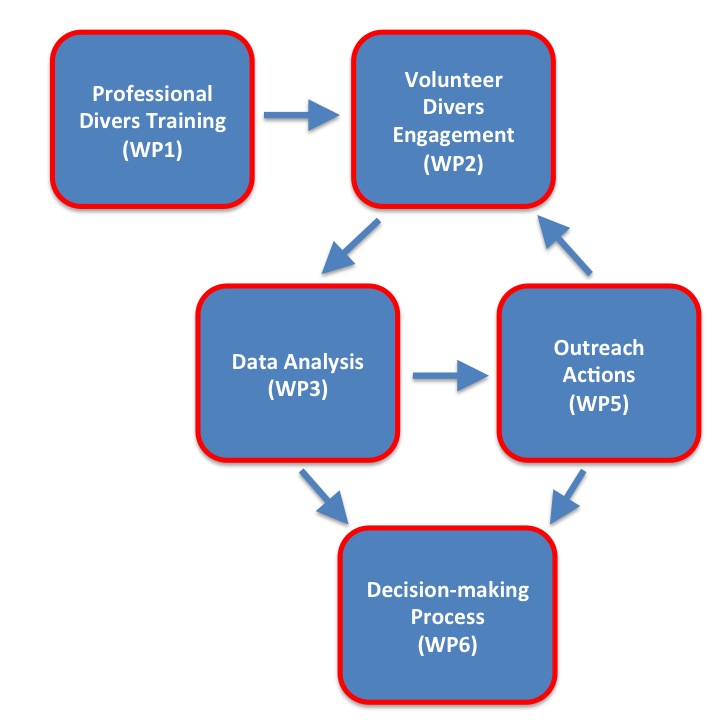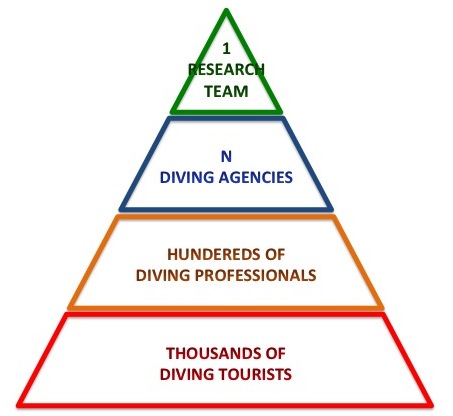“STE: Scuba Tourism for the Environment” is a Red Sea coral reef volunteer-based monitoring program which aims to:
- contribute to local environmental management and conservation. STEproject is performing a large-scale and long-term monitoring of the biodiversity status of coral reefs, that allows the detection of spatial and temporal trends of the health status of coral reefs.
- raise environmental awareness of involved volunteers. By participating in a practical conservation monitoring and through the information provided by the project staff, volunteers increase their environmental education.
METHODOLOGY
A user-friendly multi-language questionnaire for snorkelers and divers was set up and used to gather key information on coral reef ecosystem health. The questionnaire contained an initial section providing guidance for limiting anthropogenic impacts on the reef and throughout the vacation period, a second section with photographs to be used in species identification, and a third section for recording data obtained by the volunteers on animal taxa, negative environmental conditions, and recreational divers’ behaviour (download the questionnaire here).
A total of seventy-two animal taxa were included on the survey questionnaire, enabling the assessment of environmental quality based on biodiversity. All of the different ecosystem trophic levels, from primary producers to predators, were represented among the 72 chosen taxa. Using databases, literature and personal observation, organisms are chosen because they are expected to be common and abundant throughout the Red Sea, based on their natural occurrence during a typical dive. This characteristic assures that the variation in biodiversity composition detected among sites is not solely attributable to natural variation but related with local conditions and stresses. Furthermore, to assure the effectiveness of the “recreational approach”, few ad hoc actions have been taken while developing and implementing the project. The detailed species list is likely to increase the number of recreational divers involved, as volunteer interest is known to increase when familiar species are included. Moreover to assure the accuracy of the survey by volunteers, each taxon is easily recognizable and normally looked for by recreational divers and completion of questionnaires is performed shortly after the dive with the assistance of trained professional divers.
With the collaboration of targeting diving agencies, our group had trained hundreds of dive professionals that, during their daily work, ensure the participation of a mass of volunteers, triggering a cascade effect (Fig. 2). On field, divemasters and SCUBA instructors brief the divers, providing information about the habitat features, the species that may be encountered, and tips on how to minimize the impact of diving activities on coral reefs.A total of seventy-two animal taxa were included on the survey questionnaire, enabling the assessment of environmental quality based on biodiversity. All of the different ecosystem trophic levels, from primary producers to predators, were represented among the 72 chosen taxa. Using databases, literature and personal observation, organisms are chosen because they are expected to be common and abundant throughout the Red Sea, based on their natural occurrence during a typical dive. This characteristic assures that the variation in biodiversity composition detected among sites is not solely attributable to natural variation but related with local conditions and stresses. Furthermore, to assure the effectiveness of the “recreational approach”, few ad hoc actions have been taken while developing and implementing the project. The detailed species list is likely to increase the number of recreational divers involved, as volunteer interest is known to increase when familiar species are included. Moreover to assure the accuracy of the survey by volunteers, each taxon is easily recognizable and normally looked for by recreational divers and completion of questionnaires is performed shortly after the dive with the assistance of trained professional divers.
They assist the volunteers during data collection and are available for consultation in case of difficulties with species identification. Divemasters and SCUBA instructors who work with volunteers in the field, all attend the same training courses on project goals and methods (WP2, Fig. 1). The research team trained professional divers on the project objectives and methods, including taxa identification and data recording (the training program comprised lectures, video, slideshows, and field identification). Topics such as biodiversity and its application in assessing environmental change caused by natural and anthropogenic pressures were covered. The training courses were efficient because they reached a large number of diving professionals, who in turn involved recreational divers. A single trained divemaster or SCUBA instructor subsequently involves several snorkelers and divers, thus generating a cascade effect that was able to involve several thousands of volunteers. Completed questionnaires are sent to the University of Bologna, for data analysis and statistical elaboration. A biodiversity index, characterized by five classes (very good, good, mediocre, low, and very low) is calucalated. Biodiversity index is compared among sites and years, to detect spatial and temporal trends on the status of reefs along the coastal areas. To evaluate the data quality, comparisons are made between records from volunteers and independent records from a marine biologist using correlation analyses to assess agreement between the independent records.
This comparison was performed each year at different survey stations with different volunteers, to constantly monitor the validity of the data collected.In order to actively contribute to Red Sea coral reef conservation, each year the project results were presented to the Egyptian Tourism Minister and his staff, with the aim of integrating the projects finding in future environmental management actions and contribute to the development of wide conservation plans (WP5, Fig. 1). The relevant long-term dataset could also be useful for both public and private institutions and organizations interested in the conservation and management of the Egyptian Red Sea and create the baseline for future environmental health evaluations of the area. The results of STEproject are sensible also for the rest of the world, not only to the scientific community. Different stakeholders (from environmental managers to tour operators and diving agency and centers) are actually involved in the project and during the implementation of the project they have had the possibility to share information and best-practices to achieve the common natural resource conservation goal.
Dissemination activities play a key role in the volunteer involvement. Traditional and web-based media exposure first increases the enrolment of volunteers. The wide media dissemination of the project enables high citizen awareness and participation. Media also help to maintain the loyalty of volunteers. Sharing project results may help to increase the public interest in environment and biodiversity issues. Our dissemination activity results are shown on the press review page.
EXPECTED RESULTS
- Create a relevant large-scale and long-term database containing information on the distribution and abundance in the Northern Red Sea of the 72 animal taxa censused, including: sponges, corals, annelids, molluscs, crustaceans, echinoderms, bony fish, cartilage fish, turtles and cetaceans.
- Detect spatial and temporal trends of the coral reef health status and correlate them with anthropogenic activities and management actions.
- Inform the local authorities:
- on the effectiveness of current environmental management plans,
- on the identification of new areas or sites with particular conservation problems,
- how to direct future conservation efforts.
- Conduct environmental education programs, based on the practical involvement of volunteers in a monitoring program, on the information provided by the trained professionals and using the informative material (i.e. the questionnaires), to increase the environmental awareness of volunteers and head to the development of a sustainable tourism.
- Implementation of the best practices in the field of environmental assessment, conservation management and education, to be exported at global scale, for the creation of a new standard of interdisciplinary monitoring to provide meaningful data for environmental managers, including environmental awareness raising.


